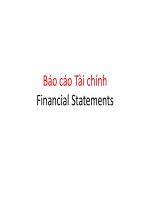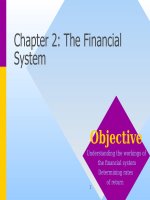Introduc corporate finance ch4
Bạn đang xem bản rút gọn của tài liệu. Xem và tải ngay bản đầy đủ của tài liệu tại đây (132.72 KB, 48 trang )
4-1
Net Present Value
McGraw-Hill/Irwin
Copyright © 2004 by The McGraw-Hill Companies, Inc. All rights reserved.
4-2
Chapter Outline
4.1 The One-Period Case
4.2 The Multiperiod Case
4.3 Compounding Periods
4.4 Simplifications
4.5 What Is a Firm Worth?
4.6 Summary and Conclusions
McGraw-Hill/Irwin
Copyright © 2004 by The McGraw-Hill Companies, Inc. All rights reserved.
4-3
The Magic of Compound Interest
• The late Sidney Homer, author of the classic, A
History of Interest Rates, said that $1,000
invested at 8% for 400 years would grow to $23
quadrillion - $5 million for every human on
earth.
• But he said, the first 100 years are the hardest.
What invariably happens is that someone with
access to the money loses patience - the money
burns a hole in his pocket.
McGraw-Hill/Irwin
Copyright © 2004 by The McGraw-Hill Companies, Inc. All rights reserved.
4-4
4.1 The One-Period Case: Future Value
• If you were to invest $10,000 at 5-percent interest for
one year, your investment would grow to $10,500
$500 would be interest ($10,000 × .05)
$10,000 is the principal repayment ($10,000 × 1)
$10,500 is the total due. It can be calculated as:
$10,500 = $10,000×(1.05).
The total amount due at the end of the investment is call
the Future Value (FV).
McGraw-Hill/Irwin
Copyright © 2004 by The McGraw-Hill Companies, Inc. All rights reserved.
4-5
4.1 The One-Period Case: Future Value
• In the one-period case, the formula for FV can be
written as:
FV = C0×(1 + r)T
Where C0 is cash flow today (time zero) and
r is the appropriate interest rate.
McGraw-Hill/Irwin
Copyright © 2004 by The McGraw-Hill Companies, Inc. All rights reserved.
4-6
4.1 The One-Period Case: Present Value
• If you were to be promised $10,000 due in one year
when interest rates are at 5-percent, your investment
be worth $9,523.81 in today’s dollars.
$10,000
$9,523.81 =
1.05
The amount that a borrower would need to set aside
today to to able to meet the promised payment of
$10,000 in one year is call the Present Value (PV) of
$10,000.
Note that $10,000 = $9,523.81×(1.05).
McGraw-Hill/Irwin
Copyright © 2004 by The McGraw-Hill Companies, Inc. All rights reserved.
4-7
4.1 The One-Period Case: Present Value
• In the one-period case, the formula for PV can be
written as:
C1
PV =
1+ r
Where C1 is cash flow at date 1 and
r is the appropriate interest rate.
McGraw-Hill/Irwin
Copyright © 2004 by The McGraw-Hill Companies, Inc. All rights reserved.
4-8
4.1 The One-Period Case: Net Present Value
• The Net Present Value (NPV) of an investment is the
present value of the expected cash flows, less the cost
of the investment.
• Suppose an investment that promises to pay $10,000
in one year is offered for sale for $9,500. Your
interest rate is 5%. Should you buy?
$10,000
NPV = −$9,500 +
1.05
NPV = −$9,500 + $9,523.81
NPV = $23.81
McGraw-Hill/Irwin
Yes!
Copyright © 2004 by The McGraw-Hill Companies, Inc. All rights reserved.
4-9
4.1 The One-Period Case: Net Present Value
In the one-period case, the formula for NPV can be
written as:
NPV = –Cost + PV
If we had not undertaken the positive NPV project
considered on the last slide, and instead invested our
$9,500 elsewhere at 5-percent, our FV would be less
than the $10,000 the investment promised and we
would be unambiguously worse off in FV terms as
well:
$9,500×(1.05) = $9,975 < $10,000.
McGraw-Hill/Irwin
Copyright © 2004 by The McGraw-Hill Companies, Inc. All rights reserved.
4-10
4.2 The Multiperiod Case: Future Value
• The general formula for the future value of an
investment over many periods can be written as:
FV = C0×(1 + r)T
Where
C0 is cash flow at date 0,
r is the appropriate interest rate, and
T is the number of periods over which the cash is
invested.
McGraw-Hill/Irwin
Copyright © 2004 by The McGraw-Hill Companies, Inc. All rights reserved.
4-11
4.2 The Multiperiod Case: Future Value
• Suppose that Jay Ritter invested in the initial public
offering of the Modigliani company. Modigliani
pays a current dividend of $1.10, which is expected
to grow at 40-percent per year for the next five
years.
• What will the dividend be in five years?
FV = C0×(1 + r)T
$5.92 = $1.10×(1.40)5
McGraw-Hill/Irwin
Copyright © 2004 by The McGraw-Hill Companies, Inc. All rights reserved.
4-12
Future Value and Compounding
• Notice that the dividend in year five, $5.92, is
considerably higher than the sum of the original
dividend plus five increases of 40-percent on the
original $1.10 dividend:
$5.92 > $1.10 + 5×[$1.10×.40] = $3.30
This is due to compounding.
McGraw-Hill/Irwin
Copyright © 2004 by The McGraw-Hill Companies, Inc. All rights reserved.
4-13
Future Value and Compounding
$1.10 × (1.40)
5
$1.10 × (1.40) 4
$1.10 × (1.40) 3
$1.10 × (1.40) 2
$1.10 × (1.40)
$1.10
0
McGraw-Hill/Irwin
$1.54 $2.16
1
2
$3.02
$4.23
$5.92
3
4
5
Copyright © 2004 by The McGraw-Hill Companies, Inc. All rights reserved.
4-14
Present Value and Compounding
• How much would an investor have to set aside
today in order to have $20,000 five years from now
if the current rate is 15%?
PV
0
$20,000
1
2
3
4
5
$20,000
$9,943.53 =
5
(1.15)
McGraw-Hill/Irwin
Copyright © 2004 by The McGraw-Hill Companies, Inc. All rights reserved.
4-15
How Long is the Wait?
If we deposit $5,000 today in an account paying 10%,
how long does it take to grow to $10,000?
FV = C0 × (1 + r )
$10,000 = $5,000 × (1.10)
T
T
$10,000
(1.10) =
=2
$5,000
T
ln(1.10)T = ln 2
ln 2
0.6931
T=
=
= 7.27 years
ln(1.10) 0.0953
McGraw-Hill/Irwin
Copyright © 2004 by The McGraw-Hill Companies, Inc. All rights reserved.
4-16
What Rate Is Enough?
Assume the total cost of a college education will be
$50,000 when your child enters college in 12 years.
You have $5,000 to invest today. What rate of interest
must you earn on your investment to cover the cost of
About 21.15%.
your child’s education?
FV = C0 × (1 + r )
T
$50,000
(1 + r ) =
= 10
$5,000
12
r = 10
1 12
McGraw-Hill/Irwin
$50,000 = $5,000 × (1 + r )12
(1 + r ) = 101 12
− 1 = 1.2115 − 1 = .2115
Copyright © 2004 by The McGraw-Hill Companies, Inc. All rights reserved.
4-17
4.3 Compounding Periods
Compounding an investment m times a year for T
years provides for future value of wealth:
r
FV = C0 × 1 +
m
m×T
For example, if you invest $50 for 3 years at
12% compounded semi-annually, your
investment will grow to
.12
FV = $50 × 1 +
2
McGraw-Hill/Irwin
2×3
= $50 × (1.06) 6 = $70.93
Copyright © 2004 by The McGraw-Hill Companies, Inc. All rights reserved.
4-18
Effective Annual Interest Rates
A reasonable question to ask in the above example is
what is the effective annual rate of interest on that
investment?
.12 2×3
FV = $50 × (1 +
) = $50 × (1.06) 6 = $70.93
2
The Effective Annual Interest Rate (EAR) is the
annual rate that would give us the same end-ofinvestment wealth after 3 years:
$50 × (1 + EAR) 3 = $70.93
McGraw-Hill/Irwin
Copyright © 2004 by The McGraw-Hill Companies, Inc. All rights reserved.
4-19
Effective Annual Interest Rates (continued)
FV = $50 × (1 + EAR) = $70.93
3
$70.93
(1 + EAR) =
$50
3
13
$70.93
EAR =
− 1 = .1236
$50
So, investing at 12.36% compounded annually is the
same as investing at 12% compounded semiannually.
McGraw-Hill/Irwin
Copyright © 2004 by The McGraw-Hill Companies, Inc. All rights reserved.
4-20
EAR and Compounding
CompoundingNumber of times
Effective
period
compounded annual rate
Year
Quarter
1
4
10.00000%
10.38129
Month
12
10.47131
Week
52
10.50648
Day 365
10.51558
Hour
8,760 10.51703
Minute
525,600
McGraw-Hill/Irwin
10.51709
Copyright © 2004 by The McGraw-Hill Companies, Inc. All rights reserved.
4-21
Effective Annual Interest Rates (continued)
• Find the Effective Annual Rate (EAR) of an 18%
APR loan that is compounded monthly.
• What we have is a loan with a monthly interest rate
rate of 1½ percent.
• This is equivalent to a loan with an annual interest
rate of 19.56 percent
r
1 +
m
McGraw-Hill/Irwin
n×m
12
.18
12
= 1 +
= (1.015) = 1.19561817
12
Copyright © 2004 by The McGraw-Hill Companies, Inc. All rights reserved.
4-22
EARs and Compounding
• The Effective Annual Rate (EAR) is ____%. The
“18% compounded semiannually” is the quoted
or stated rate, not the effective rate.
• By law, in consumer lending, the rate that must
be quoted on a loan agreement is equal to the rate
per period multiplied by the number of periods.
This rate is called the ______________ (____).
• Q. A bank charges 1% per month on car loans.
What is the APR? What is the EAR?
McGraw-Hill/Irwin
Copyright © 2004 by The McGraw-Hill Companies, Inc. All rights reserved.
4-23
Continuous Compounding
• The general formula for the future value of an
investment compounded continuously over many
periods can be written as:
FV = C0×erT
Where
C0 is cash flow at date 0,
r is the stated annual interest rate,
T is the number of periods over which the cash is
invested, and
e is a transcendental number approximately equal
to 2.718. ex is a key on your calculator.
McGraw-Hill/Irwin
Copyright © 2004 by The McGraw-Hill Companies, Inc. All rights reserved.
4-24
4.4 Simplifications
• Perpetuity
– A constant stream of cash flows that lasts forever.
• Growing perpetuity
– A stream of cash flows that grows at a constant rate
forever.
• Annuity
– A stream of constant cash flows that lasts for a fixed
number of periods.
• Growing annuity
– A stream of cash flows that grows at a constant rate for a
fixed number of periods.
McGraw-Hill/Irwin
Copyright © 2004 by The McGraw-Hill Companies, Inc. All rights reserved.
4-25
Perpetuity
A constant stream of cash flows that lasts forever.
0
C
C
C
1
2
3
…
C
C
C
PV =
+
+
+
2
3
(1 + r ) (1 + r ) (1 + r )
The formula for the present value of a perpetuity is:
McGraw-Hill/Irwin
C
PV =
r
Copyright © 2004 by The McGraw-Hill Companies, Inc. All rights reserved.









